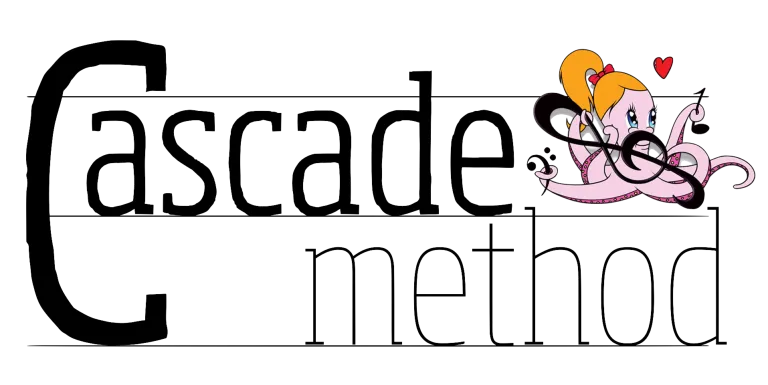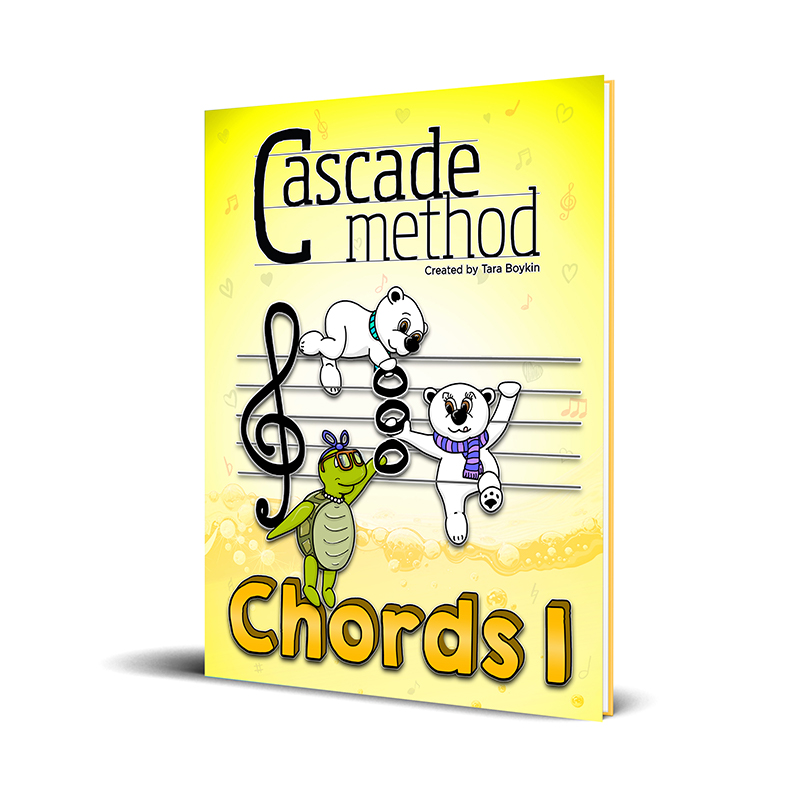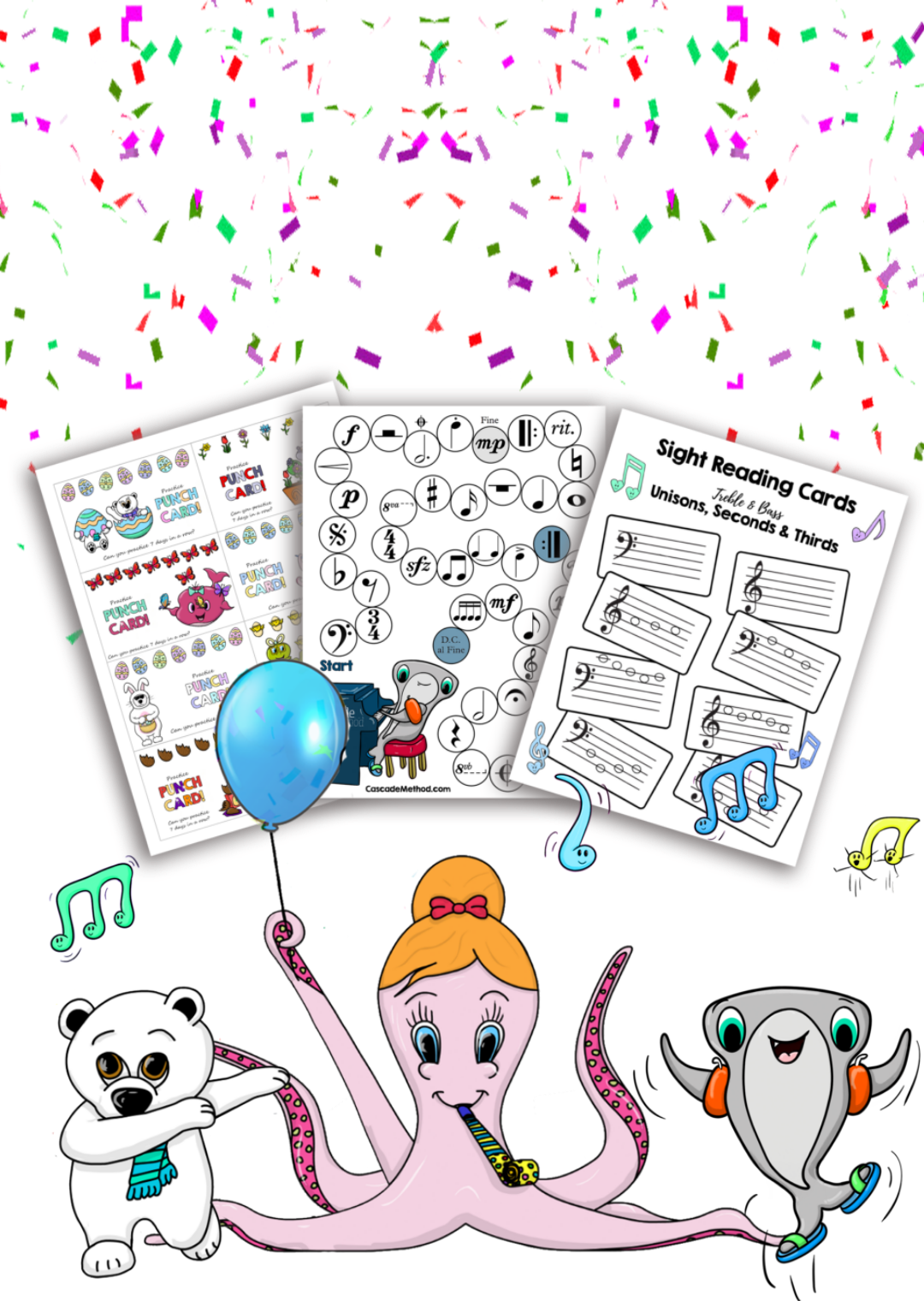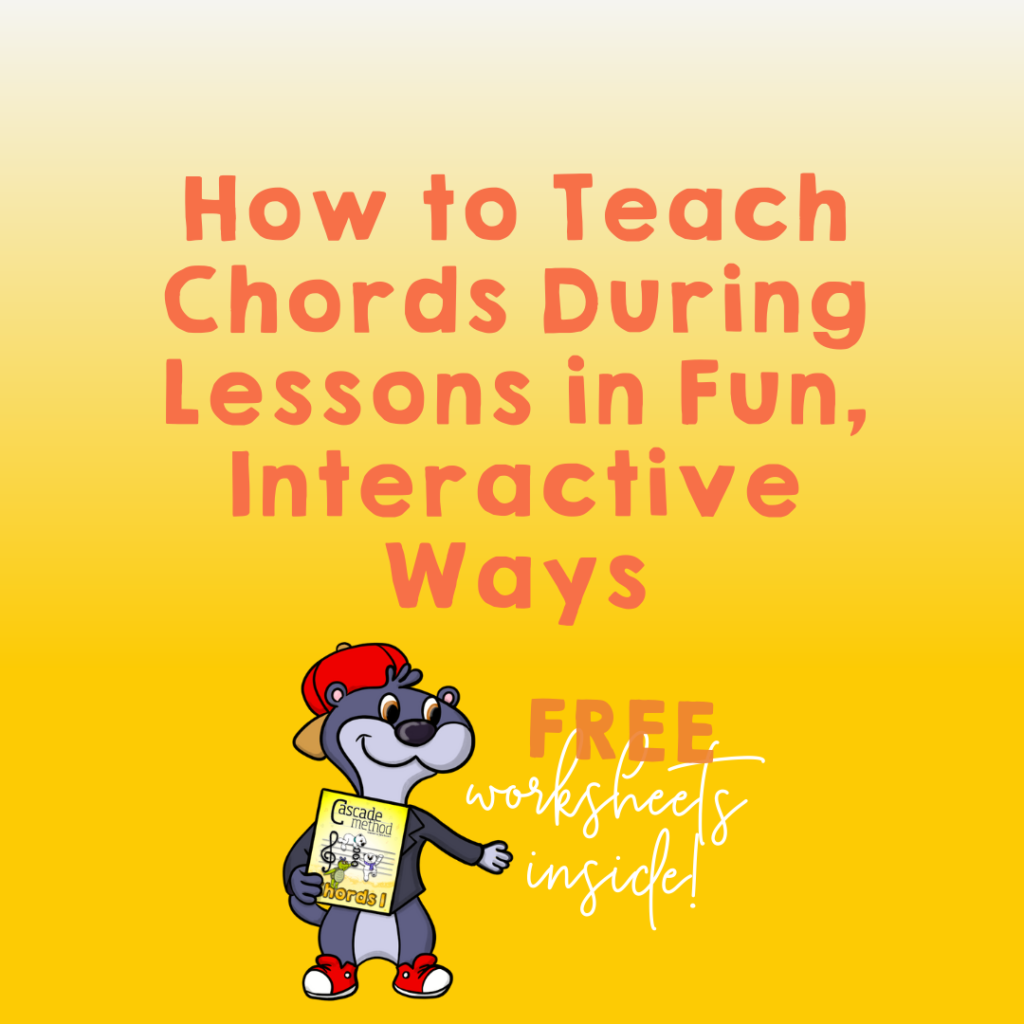
How to Teach Chords During Piano Lessons in Fun, Interactive Ways: Free Worksheets Inside!
Chords are the easiest and most fun note pairings to find! Three notes stacked so beautifully, chords tend to look a lot like snowmen! 
In honor of the holiday season, we’re going to go over all the Snowman Bonus pages in our Chords 1 Book, as well as explain some fun activities you can offer using magnets and the piano reading tool, NoteMatch! You may be able to grab all these chord pages for FREE by subscribing to the Cascade Method newsletter here!
Learning chords can be so much FUN—when you know how to do it the Cascade Method way!

Why Teaching Chords Matters
Oh, how I wish I knew and understood chords growing up! I remember learning pieces as early as five years old. If I would’ve understood chords then, not only would reading notes be so much easier, but I also would’ve learned pieces so much faster and understood the relationship between right hand melody and left hand chords!
It’s been my mission to teach students how to play the piano confidently and passionately through Cascade Method using fun teaching techniques! In my Chords 1 Book, we go over everything there is to know about chords. We reinforce chord reading, teach students how to notice chords throughout any given piece, help them understand chord patterns, and much, much more.
Learn the entire Chords Book 1 curriculum and how it’s laid out!
When Students Understand Chords…
There are so many pieces, especially for BEGINNERS, where the notes in the right hand are “family” with the left hand chord. When you understand chords, you are essentially memorizing one entity rather than three notes. When students change their mindset from learning three separate notes and start to visually see and recognize the three notes (chord) as a whole, they learn so much quicker and get less overwhelmed!
I’ve come to realize when learning the three notes, if you identify the bottom note first, the rest is a piece of cake—just simply stack the other two top notes (by skipping on the piano) and there you have it!
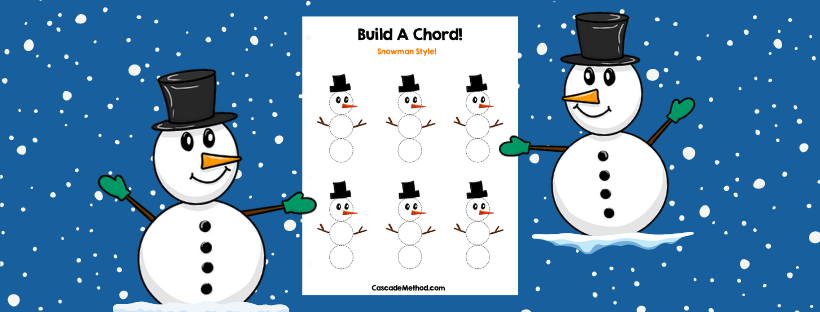
Representing chords as snowmen is not only extremely cute, but it makes it so much fun and helps the student to see the notes as a whole, rather than separately. You can’t have a snowman without THREE snowballs, AKA: THREE notes!
Learning chords also plays a significant role in reading music, but another reason I personally love to teach chords is that it’s how I prep my students for the pop song method. Laid out on each new chord in the Chords 1 Book, there’s a spot in the top left corner of the page that guides students to write in the “pop symbol” for that chord. This simple step reinforces all the pop symbols, so when they’re ready to learn the pop song method, they already know the symbols!
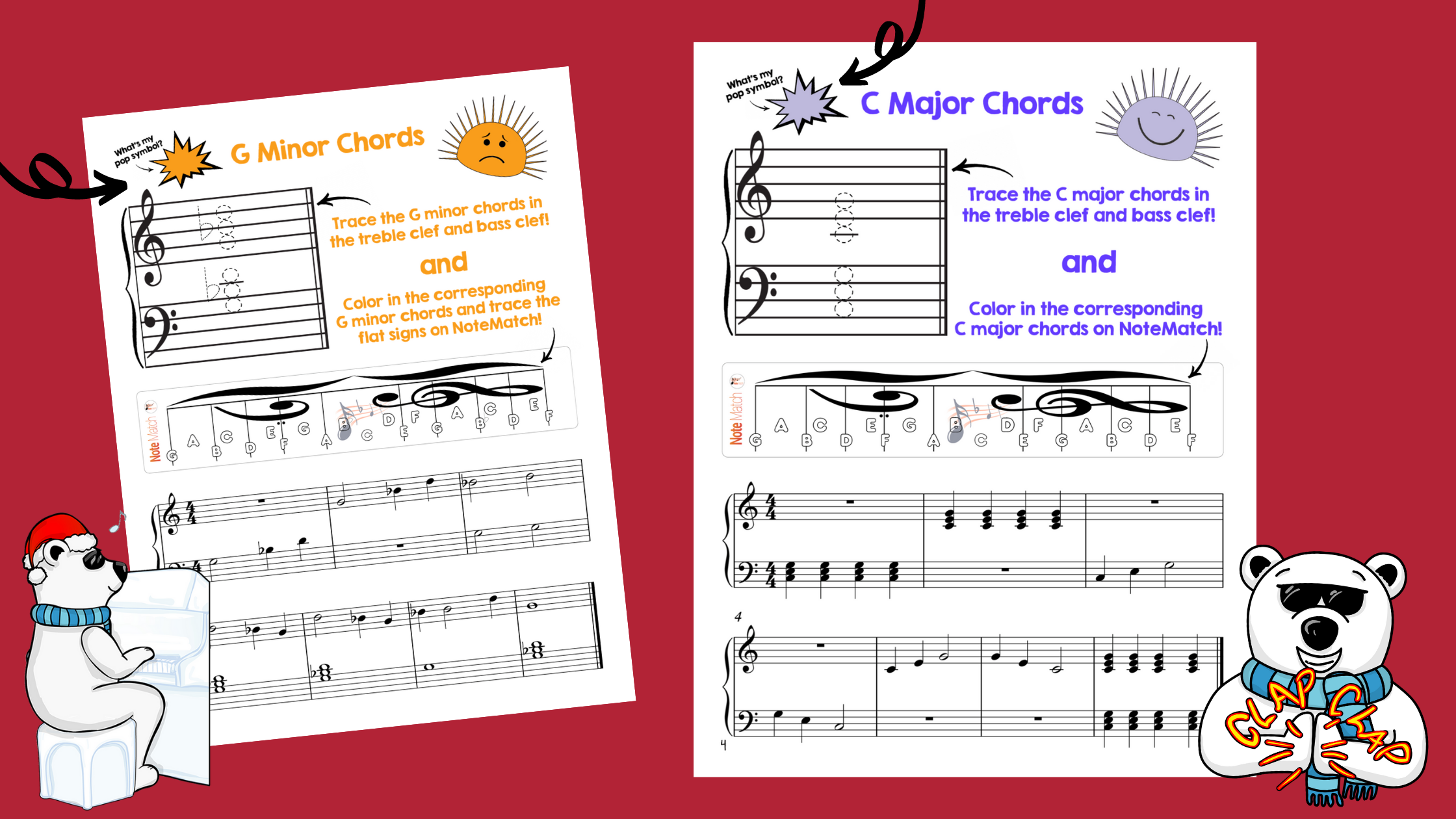
From playing with the pop song method to composing and improvising to playing through fake books, chord knowledge will take your students so far in their musical journey.
How do you teach chords by resembling them to snowmen?
When finding the chords, all you need to do is look at the bottom of the three notes, as in the “butt” of the snowman! If you understand the “bott-om” note (PUN INTENDED?), then you can play the chord! Sometimes, the snowman is missing a “head,” so you play the bottom two notes; whereas, other times he’s missing his “belly,” so you play the bottom and top note!
Are you starting to see how this can help a child to understand where to play on the piano? ?
Once the student plays the chord on the piano by knowing the bottom note, they can then use their ear to identify if it’s a “happy” (major) or a “sad” (minor) snowman! Depending on what they hear, they will then add a smile or frown to their snowman.
If it’s a happy snowman, they leave the bottom note they wrote in alone and add a smile to the snowman. If it’s a sad snowman, they have to add a little lower case “m” to the right of the note (meaning its a minor chord), and then add a frown to the snowman because he’s sad!
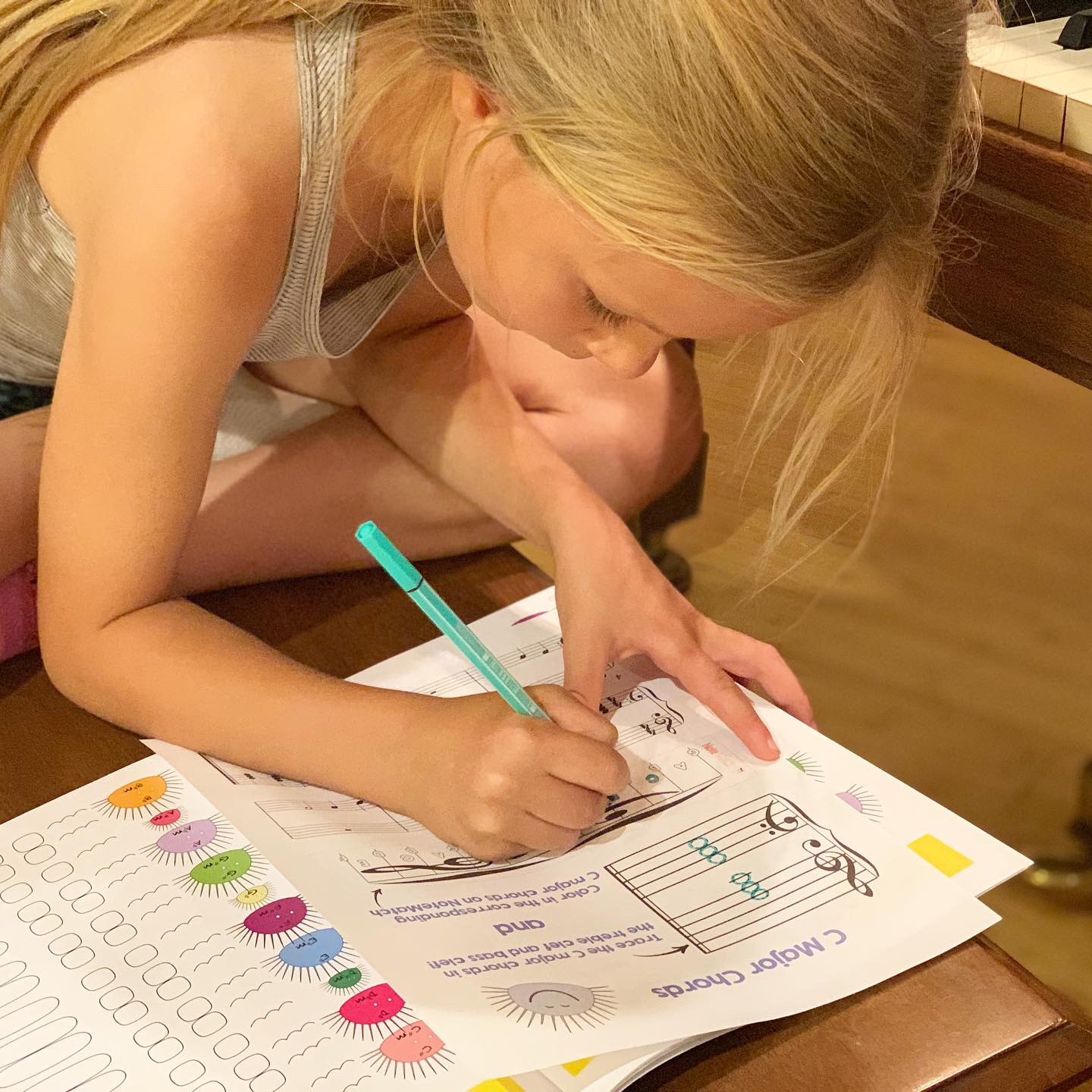
Let’s do some practice!
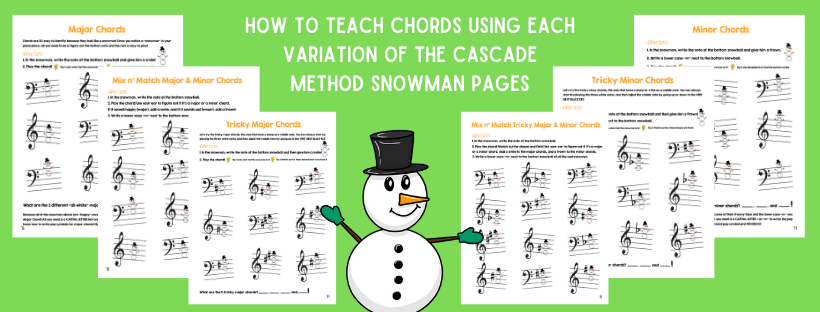
How to Teach Chords Using Each Variation of the Cascade Method Snowman Pages
Learning MAJOR CHORDS: Snowman Edition!
This page (starting on page 76 in the Chords 1 Book) covers all the simple major chords, as in the “happy chords” that don’t need any sharps or flats.
This means that once the student identifies the bottom note, they can play the whole chord without having to do any thinking! When I ask students to write the bottom note of the snowman, it’s also teaching them the pop symbol for that chord!
Let’s do an example!
The first chord on the page shown is a C chord. Per the directions, students will need to write the note name of the snowman’s bottom “snowball.” By doing that, not only have they learned the pop symbol, they can now play the chord according to the “pop symbol!” For added bonus fun, because it’s the major chords page, students can also add a little smile to the snowman.
We want to also help our students associate a solo capital letter with major chords. They should know that solo capital letters automatically stand for a major chord. There’s no need to add anything extra—a capital letter stands for “Major!” So, “C” means C major, D means D major, and so forth.
PRO TIP: Make sure your students are always writing with “capital letters” in the snowman’s bottom snowball. Lower case letters either “don’t exist” or mean something else. Capital letters always stand for Major!
At the bottom of the page, students recap what they learned, (in this case), by noticing that there are only THREE MAJOR CHORDS that are “all white.” (C, F, and G)!
Learning MINOR CHORDS: Snowman Edition!
The next page is the same format as the major chords, but covers all the “white” minor chords.
There are a few differences to point out:
- After all the steps we already laid out for the major chords page, on the minor chords page, students will need to add a little lower case “m” near the capital letter they wrote in the bottom snowball. Adding that lower case “m” is teaching them the pop symbol for minor chords. If it isn’t there, the musician will play the major version of that chord which we don’t want!
- Another simple difference from the major page is that students should draw in a frowny face for the snowman since it’s a minor chord!
At the bottom of the page, students recap what they learned, (in this case) by noticing that there are only THREE MINOR CHORDS that are “all white.” (Dm, Em, and Am)!
The Mix n’ Match Major & Minor Chords Snowman Page
Basically, this page recaps both prior pages BUT the caveat is students won’t know right away which chords are major or minor! This guides students to use their ear in order to determine whether the chord is major or minor, (and happy or sad)!
They will write the bottom note as usual, play the chord, and then listen to identity whether it’s happy or sad. This page reinforces a student’s awareness/consciousness of sounds. The other pages give it away because they already knew it was only major chords or only minor chords!
Tricky Major Chords: Snowman Edition!
This page is the same as the major chords page but there’s an extra little step students need to do when playing the chord. These chords have a “sharp,” (there’s even two for B major)!
Learning these “tricky major” chords (as I like to call them) complete all the “major chords” that start with a white note on the bottom. So once they write in that bottom note (which also doubles as the pop symbol), they just have to be careful when playing all three notes – where JUST the middle note needs to be raised by half a step! (EXCEPT FOR B MAJOR… which I always tell students is “annoying!” We like to say B is BONKERS!)
PRO TIP: I also like to remind students that for most of these tricky chords, most being ALL CHORDS except B major, that you NEVER CHANGE THE OUTER NOTES!!! Sometimes kiddos will freak out when they see sharps, and can’t tell which note it’s trying to change. When it comes to these chords, all we’re changing is the middle note. (Again, except for B major. Ugh, so annoying, right!? Haha)
Tricky Minor Chords: Snowman Edition!
This is the same page as “Tricky Major Chords” but covers the “tricky” minor chords! The only difference is that almost ALL chords have a flat in front of the middle note, so this time, instead of going up a half step, they’re going down!
Don’t forget… the B minor chord is the exception to this page as well! Not only does it not have a flat in front of the middle note, it has a SHARP for the TOP note!! (Crazy B chords!! Just remember: B CHORDS are BONKERS!) ??
The Mix n’ Match Tricky Major & Minor Chords Snowman Page
This page mixes all these crazy chords up and has the same format as the first “Mix n’ Match” page. So, they’ll have to use their ear to see which snowmen are happy, or sad (and also add the lower case “m” to the sad snowmen).
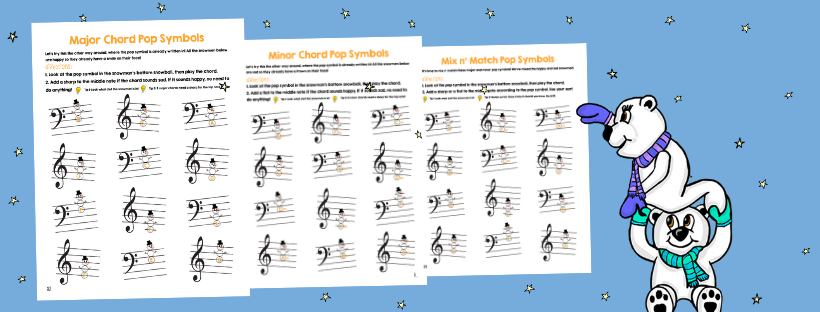
The Last Snowman Pages: Major Chord Pop Symbols & Minor Chord Pop Symbols + Mix n’ Match Version
The last set of pages teach students to play chords the other way around, where the pop symbol is already there! They have to use their ear to turn the chords to major or minor, according to the pop symbol. Some chords will stay all white, while others, students will need to add either sharps or flats to the middle note (and extra sharps to B major and minor chords)!
DOWNLOAD ALL THE PAGES FOR FREE BY SUBSCRIBING TO OUR EMAIL LIST!
But wait, there’s more!
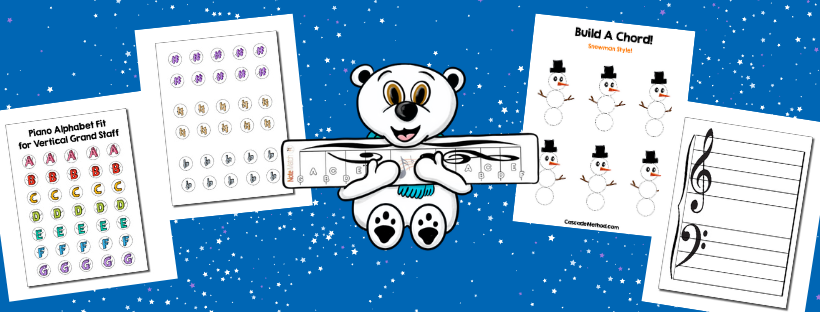
Moving on to Fun Chords Activities Using the Snowman Pages and NoteMatch!
FUN LEARNING ACTIVITIES REVEALED:
Build a Chord ~ Snowman Style Worksheet!
This additional worksheet that can be purchased (for $1!!!) on the Cascade Method Online Shop can be used in several fun ways! To make it last longer, I would suggest laminating it, allowing students to easily reuse it!

This is a great skill to learn! Being able to jump letter names, as in, C to E, or G to B, or B to D! Once they understand that that’s how it works, it starts making sense on the piano too!
Here’s How to Play: Once the worksheet is laminated, you can tell your students to write out a C major chord (for instance). This is where they can write out the three notes in each snowball! I would start out with the easy chords that don’t involve sharps or flats and then don’t forget to have them add the smiley or frowny face, depending on the chord! *For this activity, I would use the blank snowman worksheet so that kids can easily write in the third note (top snowball).
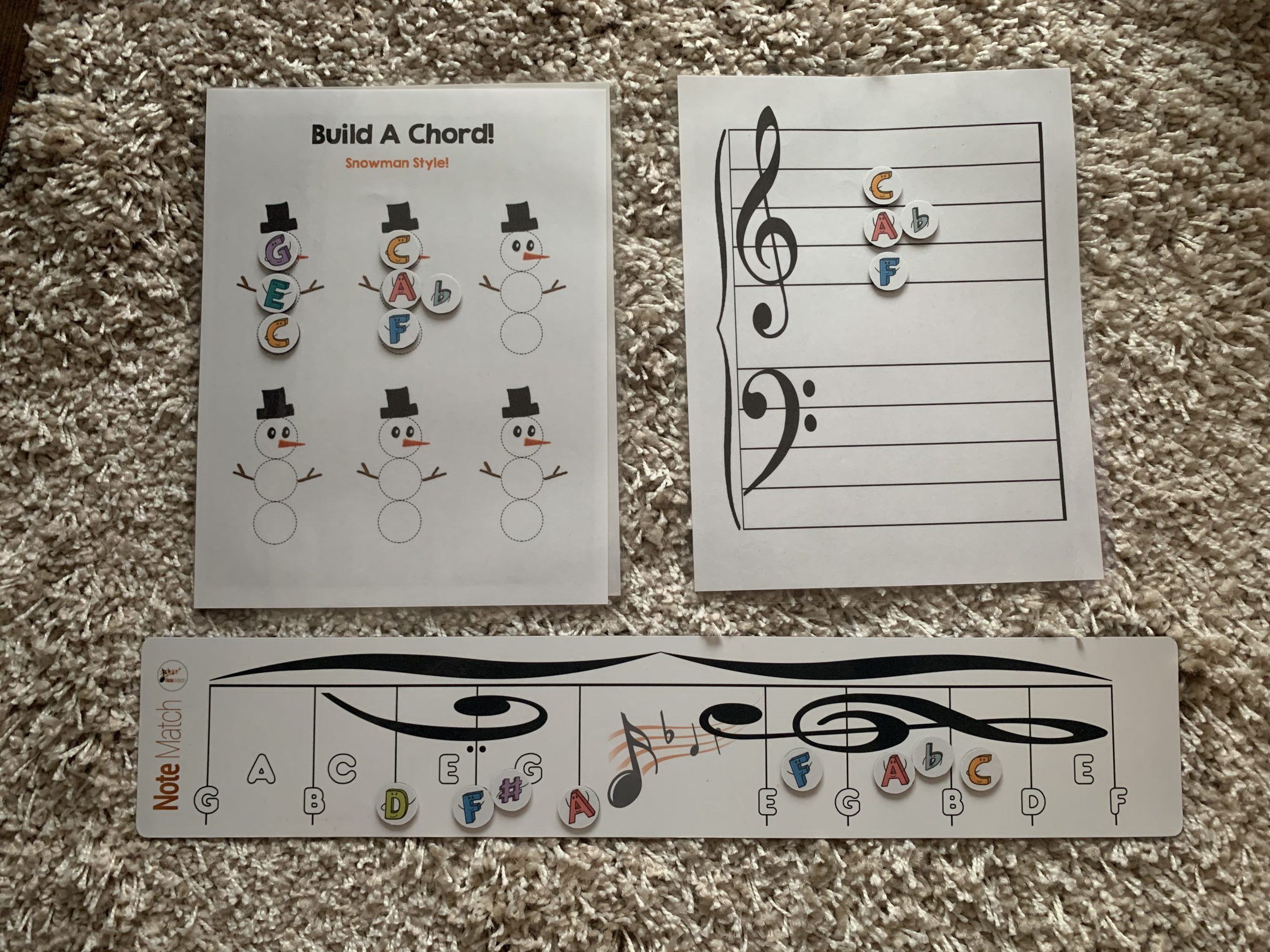

Also on the Cascade Method online shop are round, little alphabet letters that can be turned into magnets: Check out the Piano Alphabet Fit for Vertical Staff print-out! I even included little sharps and flats in the deck! Personally, what sounds most fun to me is turning those little round alphabet letters into magnets, and combining the chord building experience with the snowman chord page (you will also have to attach a magnet sheet to the worksheet page).

Once students build the chords with magnets on the snowman page first, then have them transfer the chords to NoteMatch, which is a step closer to “sheet music.” Once they know how to place it on NoteMatch, have one final transfer over to the vertical grand staff! You can purchase the vertical grand staff print out here!
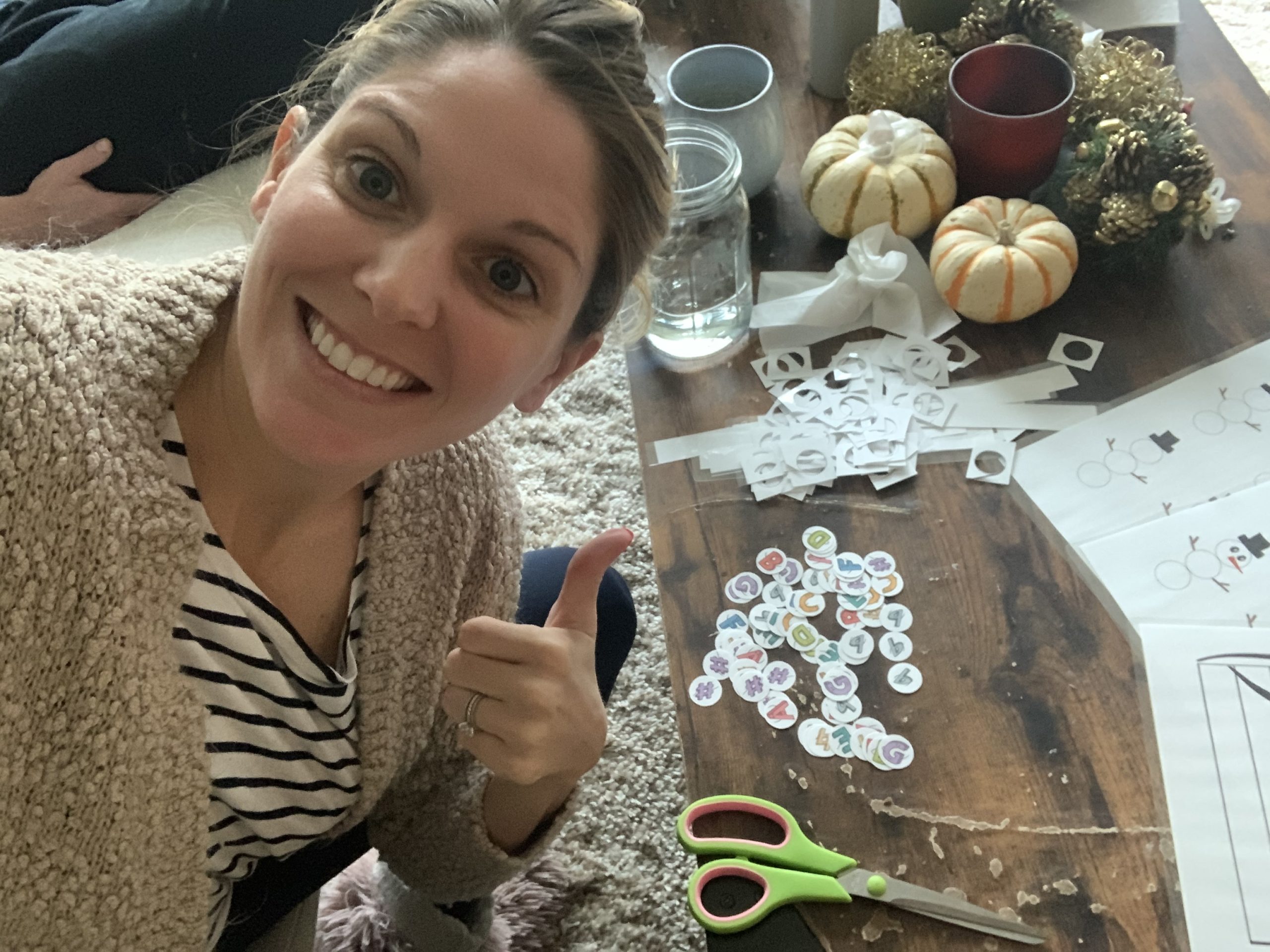
Allow Your Students to See All Three Variations of a Chord By Using Magnets!
You can print out the alphabet as many times, giving your students enough magnets to use for each worksheet. Once the kids write in the notes (C, E, G), they can cover them up with the magnets, and then use another set of the same magnets to put on NoteMatch, and use another three identical magnets to put on the grand staff page! So now, they can visually see ALL three versions—from the snowman page, to NoteMatch, to what it looks like on the staff!! What a great way to start learning chords easily and slowly transferring them to the staff.
Allow me to walk you through it again over video and see the magic in these magnets!
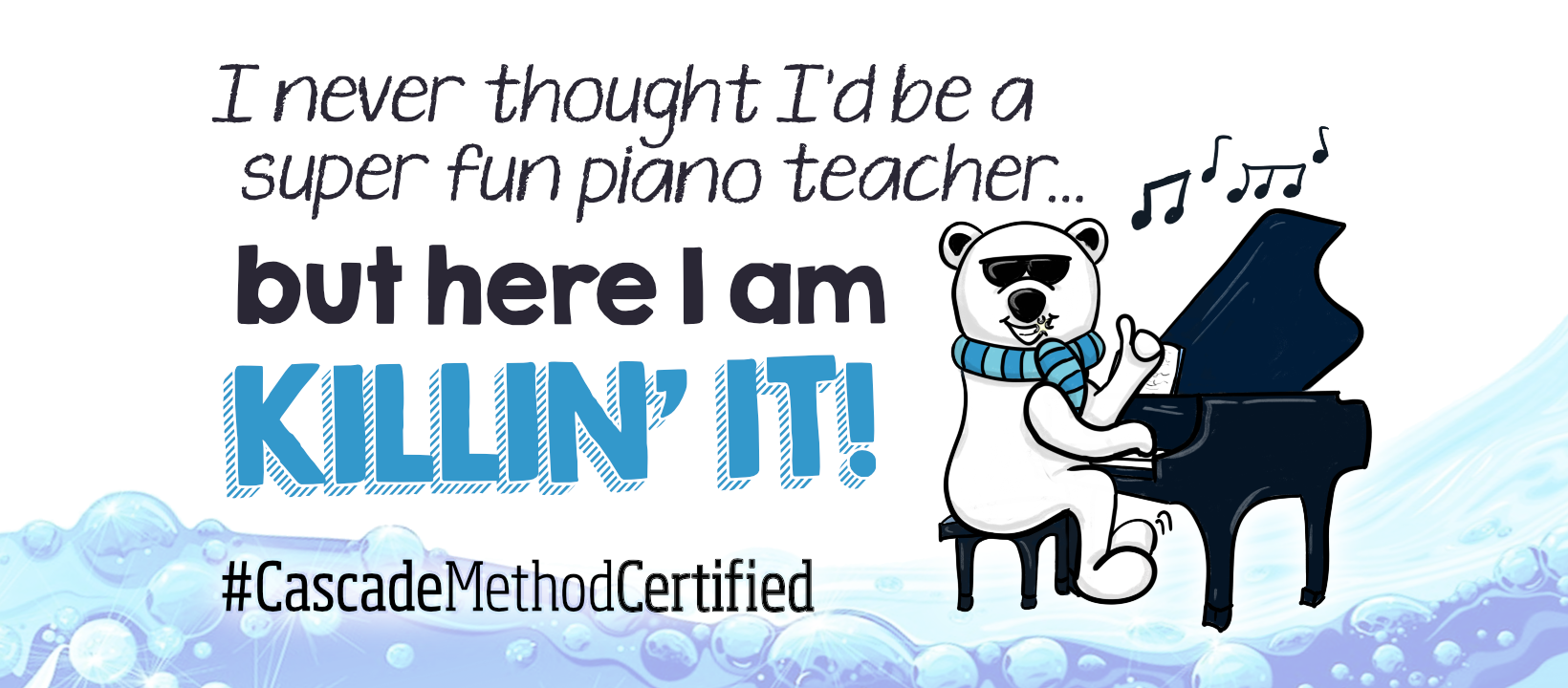
Ready to join in on the fun?
DOWNLOAD ALL THE SNOWMAN PAGES FROM THE CHORDS 1 BOOK + THE ADDITIONAL SNOWMAN WORKSHEET FOR FREE HERE!
These methods work and the activities are FUN! Let your kiddos learn chords easily so they can make strides in their musical journey! To learn more about NoteMatch, click here! If you’re interested in obtaining more teaching tricks, consider becoming a Certified Cascade Method Teacher!
Watch how these magnets can be used in a number of ways here!
Purchase a copy of the Chords 1 Book on Amazon or the Cascade Method Online Shop!
Shop all the Cascade Method Games and Activities here!
